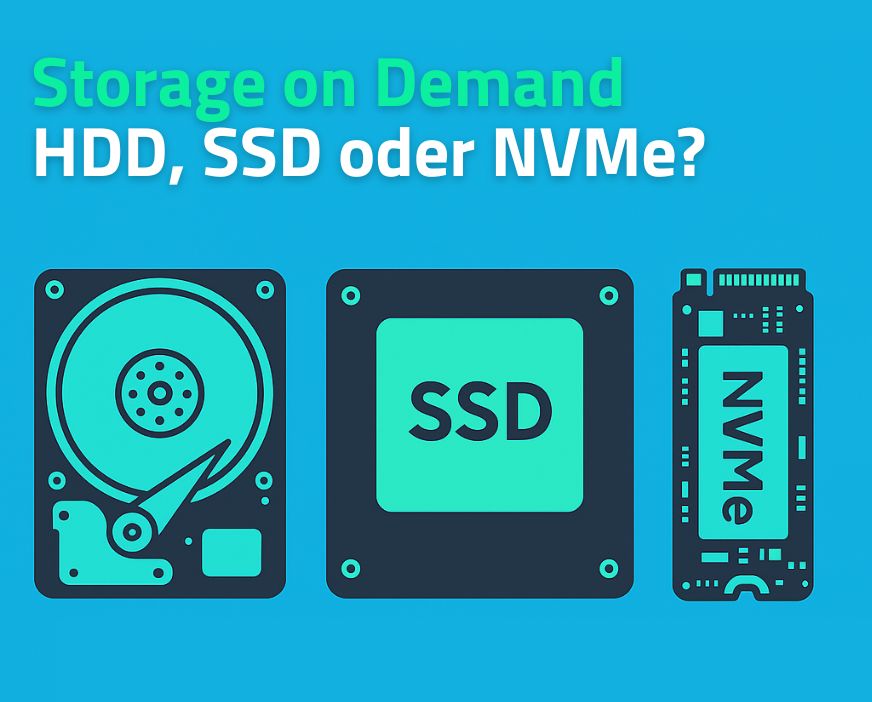Why storage is not just storage
Not every type of storage is designed for every task. Anyone who has ever tried to run a backup system on a USB stick or operate a highly available database on a simple NAS knows this. Today, companies face a wide range of storage technologies that differ in capacity, architecture, and purpose. The storage needs of a video archive with several petabytes of unstructured data look completely different from those of an SQL database for real-time analytics or a development team testing and discarding virtual machines.
To illustrate the differences, here are some examples:
- File Storage (i.e., file-based storage) is used in classic file servers. Here, multiple users access shared directories, as you know from IT in an office.
- Block Storage, on the other hand, is often used for databases or virtualized systems. Here, the storage is divided into blocks that are addressed like physical hard drives. This is ideal for high performance and transaction-heavy applications.
- Object Storage is particularly suitable for large amounts of unstructured data, such as images, videos, or backup files. These are stored as objects with metadata, perfect for scalable cloud environments or media archives.
Each of these systems has its own logic, requires special hardware or software, and incurs costs. For example, those who want high availability must invest in redundant storage architectures. RAID arrays, mirrored hard drives, geo-redundant data centers: all of this is expensive to acquire (CAPEX) and causes ongoing operational costs. Especially when growth cannot be precisely planned.
This is precisely where Storage on Demand comes in. It’s an operational model where storage is no longer rigidly purchased, but flexibly used and billed according to actual needs. But what exactly does this mean, and when is which storage the right choice?
What is Storage on Demand?
Storage on Demand means providing storage resources flexibly: when they are needed and to the necessary extent. Unlike traditional storage solutions, where companies buy infrastructure “in stock” (and often oversize), Storage on Demand follows the principle: use instead of own. Technically, this is usually realized through virtualized storage platforms in data centers that can be dynamically scaled. Comparable to a power connection: you only pay for what you consume.
A concrete example: A company processes large amounts of data once a quarter for a market research campaign. Instead of permanently maintaining expensive high-performance storage for this, it can temporarily rent it: for instance, via an S3-compatible object storage solution or block storage for virtual machines. Once the processing is complete, the storage is released without long-term commitment or unused capacities.
Storage on Demand can be provided both locally (for example, via a data center with a direct connection to the company network) and cloud-based. What’s important is not the location, but the principle: capacity, availability, and performance are aligned with actual needs.
What advantages does Storage on Demand offer?
The biggest advantage is obvious: cost control through flexibility. Companies no longer invest in storage they may never fully use. Instead, the storage infrastructure is considered as ongoing operational expenditure (OPEX), similar to electricity or water. This reduces capital commitment and makes IT better plannable and scalable.
Other advantages at a glance:
- Fast provision: New storage resources can be activated in minutes without physical hardware.
- Scalability: Storage capacity grows with the company and its increasing storage needs.
- High availability on demand: Many Storage on Demand offerings include various redundancies, geographical distribution, and fault tolerance.
- Technological freedom: Users can choose between different storage types (block, file, object) and platforms (proprietary or open source), depending on the use case.
- Lower risk for innovations: Those who want to test new applications (such as AI workloads or data analysis) can temporarily book storage resources without having to purchase and maintain infrastructure long-term.
On-demand storage is therefore particularly useful when storage requirements change, are difficult to plan, or increase rapidly and unpredictably. It enables low-risk and highly efficient responses to dynamic requirements.
Which storage is the right one and when?
Not every storage type is suitable for every use case. Ignoring this risks unnecessary costs or even data loss. The choice of the right storage depends on several factors: type and structure of data, access speed, availability, scalability, and not least legal or regulatory requirements such as data protection or retention obligations.
Here’s an overview of the three main types of storage technologies and typical use cases:
1. File Storage: for structured, shared files
File storage stores data in a hierarchical structure of folders and files, as known from conventional file systems. This makes it particularly suitable for environments where many users access the same documents:
- Typical applications: File servers, home directories, office documents, project drives
- Advantages: Simple handling, controllable user rights, compatible with common operating systems
- Limitations: Less suitable for high performance or massive scaling
2. Block Storage: for high-performance, structured data
Block storage divides data into equal-sized blocks that are stored and addressed independently. The logic of the data structure lies with the operating system or application, not with the storage itself.
- Typical applications: Databases (e.g., MySQL, Oracle), virtualization (VMware, Proxmox), transaction systems
- Advantages: High speed, low latency, ideal for I/O-intensive applications
- Limitations: No metadata management, more complex integration, more expensive for large-scale scaling
3. Object Storage: for large amounts of unstructured data
Object storage stores data as objects, including metadata and a unique ID. Unlike file or block storage, there is no classic directory structure here. Instead, scalability and access via APIs are in the foreground.
- Typical applications: Backups, media archives, Big Data, AI/ML data, cloud-native applications
- Advantages: Excellent scalability, easy distribution across locations, ideal for cloud scenarios
- Limitations: Higher latency, not suitable for transactional workloads
What does this mean in practice?
A software company hosting virtual machines needs performant block storage. An advertising agency with a large media archive relies on object storage. And an administration where employees access central documents daily does well with file storage.
There is no single right storage for everything. Often, hybrid concepts make sense, such as file storage for operational work and object storage for audit-proof long-term archiving. The crucial point is to analyze the requirements and align the storage strategy accordingly.
Why high-availability storage solutions are expensive
When storing enterprise data, one must consider not only capacity and speed but also fail-safety. Because a storage location that cannot be accessed in an emergency is practically worthless. Especially in critical areas such as e-commerce, finance, or healthcare IT, a failure can have dramatic consequences: from revenue loss to reputational damage to legal consequences.
In practice, high availability means: Data must be accessible at all times. Even in case of hardware failure, power outages, or network problems. To ensure this, extensive technical measures are necessary, including:
- Redundant hardware components (e.g., RAID systems, hot-spares)
- Mirroring of data across multiple servers or locations (for example, geo-redundant storage solutions)
- Failover mechanisms for automatic switching in case of failures
- Power supply via UPS and emergency generators
- Monitoring and 24/7 support infrastructure
All of this involves considerable effort and high investment costs, both in acquisition (CAPEX) and ongoing operation (OPEX). An example: Anyone wanting to build a highly available storage cluster internally must invest not only in duplicate hardware but also in corresponding network infrastructure, cooling, security measures, and specialized personnel. For many companies, especially in the mid-market sector, this is not economically realistic.
This is where Storage on Demand comes into play
Instead of investing in expensive high-availability architectures themselves, companies can use these as part of an “as-a-service” model, tailored to their needs, scalable, and without long-term capital commitment. The underlying infrastructure is provided and maintained by the data center operator, who ensures security and availability.
A practical example:
A SaaS provider stores customer data in a highly available object storage that is mirrored across two locations. Instead of operating the technology themselves, they use a storage-on-demand platform with 99.99% guaranteed availability. If one component fails, a second storage location automatically takes over. For the SaaS provider, this means: maximum failover security with predictable costs without their own investments in redundant systems.
Through the usage-based billing model (pay-as-you-go), the company only pays for the storage capacity actually used. Scaling up or down is possible at any time. This makes the storage solution ideal for growing data volumes, seasonal usage, or temporary projects.
When is storage on demand worthwhile and what should companies look out for?
Storage on demand is particularly useful when companies need to respond flexibly to changing requirements, want to avoid high investments in their own storage infrastructure, or have specific requirements for failover security, scalability, and availability. The model is suitable for both continuously growing data volumes and temporary projects or highly fluctuating usage scenarios.
Storage on demand is not a one-size-fits-all solution. It’s crucial to choose the right type of storage for the specific purpose, whether block, file, or object storage, and to integrate it sensibly into your own IT architecture.
Companies that want to make their storage strategy future-proof, cost-transparent, and scalable will find in storage on demand a flexible alternative to traditional in-house infrastructure with the advantage that they only pay for what they actually use.
Reserve capacities now
Ready for the Digital Future? Secure your capacities in the AI-Ready Greenfield data center now!








